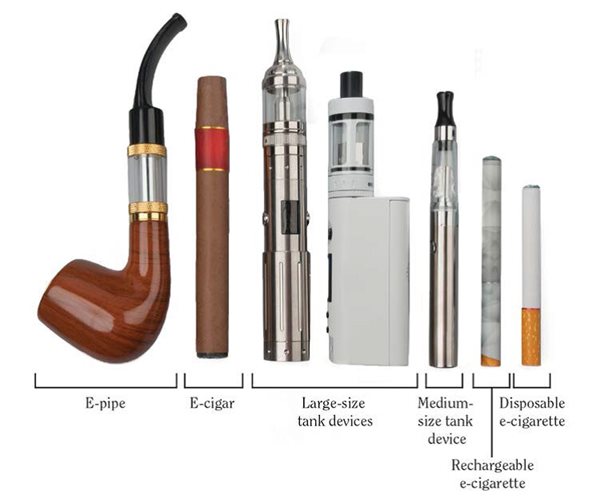As a doctor specializing in lung diseases, I have seen the negative outcomes that result from smoking and tobacco use. I also know that patients, who are trying so hard to quit, often begin using e-cigs, vaping devices, etc. instead of cigarettes. Many patients ask me if “vaping” is a better option than cigarettes.
I tell them the answer is complex.
Let me start with this statement: all current available data tells us that e-cigs/vaping are less harmful than tobacco use. That being said, it’s been shown that most smokers who casually attempt to quit smoking using e-cigs end up smoking both regular cigarettes and e-cigarettes.
Additionally, youth who start with using vaping devices are more likely to also become cigarette users.
What is an e-cigarette?
Smokefree.gov defines e-cigarettes as battery powered devices that work by heating a liquid into an aerosol that the user inhales and exhales. The e-cigarette liquid typically contains nicotine, propylene glycol, glycerin, flavorings, and other chemicals.
As indicated in the photo, there are many kinds of e-cigarettes. Some look like traditional tobacco products and some do not.

You may have heard your teenager or college student talk about
JUUL. It’s the brand name of an e-cigarette that resembles a USB or “flash” drive. According to the non-profit group Truth Initiative, in just two years on the market, JUUL has already “amassed nearly half of the e-cigarette market share.”
Photo from https://truthinitiative.org/news/what-is-juul
What’s in an e-cigarette?
There are a number of chemicals involved in e-cigs/vaping. First is the PEG, polyethylene glycol, which is the “carrier” of the other contents in vaping devices. (In JUULing, we don’t know as much about the “carrier” substance.)
PEG is thought to be a harmless food additive and is the same medium often used for theatric “smoke” and lighting effects at concerts and shows. We know that people with lung conditions can have trouble with PEG, and studies are only now looking at PEG as a heated, inhaled substance.
Second is nicotine. Nicotine is the addictive substance that causes people to become hooked on these devices and all tobacco products. Nicotine is no longer thought to be an otherwise harmless chemical, and has been linked to the development of COPD, and implicated in other negative health outcomes. (According to the product website as it relates to nicotine, a single JUUL cartridge is roughly equal to a pack of cigarettes, or 200 cigarette puffs.
https://truthinitiative.org/news/what-is-juul)
Third is formaldehyde and heavy metals. Formaldehyde is a probable carcinogen – it can cause cancer - and promotes respiratory issues such as bronchitis. Vapor from e-cigs has as much formaldehyde as cigarette smoke. On top of that, to generate vapor, e-cigs heat the chemicals inside the device, leading to heavy metal particles from the heaters being detectable in the vapor/smoke.
Are teens using e-cigarettes?
In a recent report regarding tobacco/nicotine use in Indiana, it was stated that 29% of Hoosier 12
th graders report use of e-cigarettes/vaping. This number is similar to national trends.
Teen vaping is a major public health concern, and here’s why:
- As I mentioned earlier, vaping is a gateway drug. Youth who start with using vaping devices are more likely to eventually become cigarette users as well.
- There is concern about the effects of nicotine on the developing adolescent brain, especially the part responsible for regulating attention and judgment.
- We know that smoking among adolescents is associated with impaired attention, working memory and ability to concentrate. Nicotine is thought to be the cause of these problems.
- There are studies that support smoking as a risk factor for impaired cognitive function later in life.
- Nicotine addiction is incredibly hard to break. Kids could be setting up a habit they may struggle with for the rest of their lives.
Another point of note is that many—if not most—e-cigs products are sponsored by big tobacco companies. These companies are interested in maintaining their market share, and in my opinion, they’re not too concerned about whether their market is people who vape, people who smoke cigarettes, or both.
We—parents, doctors, society—should be concerned about the use of flavors, such as bubble gum, cotton candy, ‘frutti tutti’ and other tastes that are clearly used to entice young people into using these products.
One of my favorite expert authors on the subject of tobacco, vaping, and marketing of such products is Dr. Stanton Glantz who is professor of medicine at UCSF.
In his writings, Dr. Glantz points out that the FDA has been relatively ineffective in limiting use and protecting children from e-cigs. He strongly recommends that local communities create ordinances to restrict use of these products. (This strategy has worked well in California.) Taxation of vaping products can also reduce rates of youth vaping. It’s been proven to work with traditional tobacco products.
Dr. Glantz has published multiple articles about the marketing of vaping products. Here is one of particular interest:
https://tobacco.ucsf.edu/ftc-should-collect-and-release-detailed-information-e-cigarette-marketing-and-promotions
Additionally, Georgetown University's School of Nursing & Health Studies has published a recent article,
With the Jury Out on Vaping, Clinicians Pause to Identify the Cons of E-Cigarettes. The article discusses key social factors that influence adolescent e-cigarette use, along with significant statistics regarding this issue in the United States. Also highlighted is how e-cigarettes are often a gateway to tobacco use.
To learn more
Here are some additional websites to help explain the basics of e-cigarettes and the health effects of smoking and/or vaping:
https://e-cigarettes.surgeongeneral.gov/
https://www.cdc.gov/tobacco/basic_information/e-cigarettes/index.htm
http://www.publichealthlawcenter.org/sites/default/files/resources/tclc-guide-reg-ecigarettes-2016.pdf